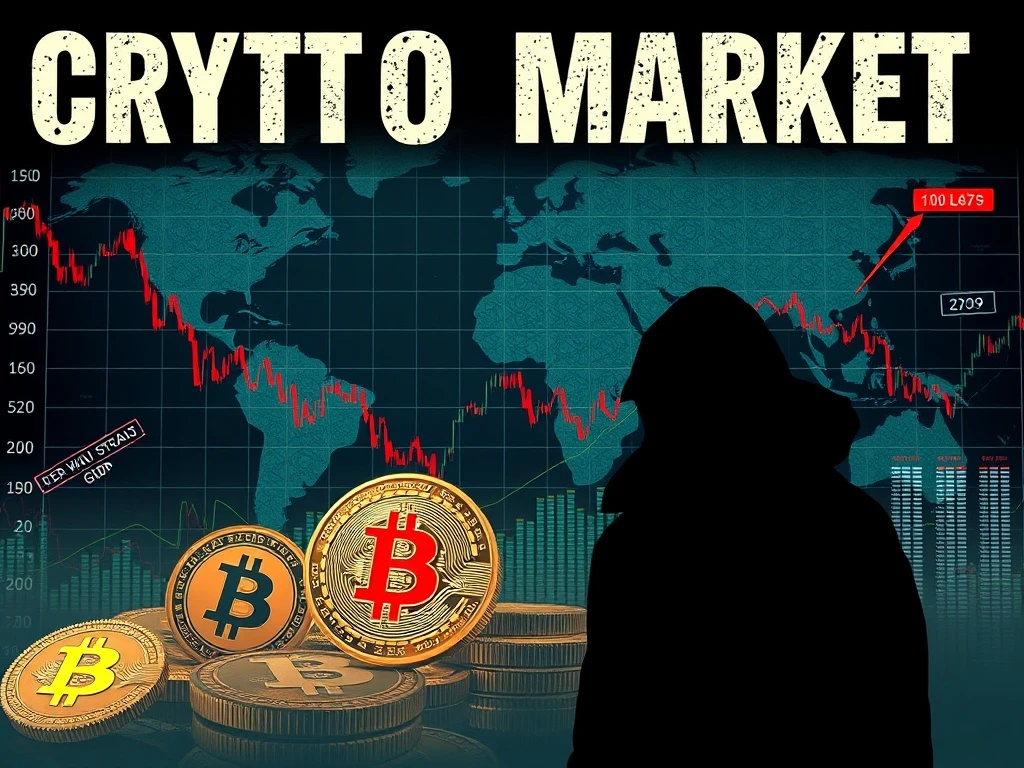Crucial Warning: Crypto’s Next Bear Market Triggered by Business Cycle, Says Willy Woo

The cryptocurrency world constantly seeks to understand its unpredictable cycles. However, a crucial warning from renowned analyst Willy Woo suggests that the next crypto bear market will stem from an entirely new trigger: a global business cycle downturn. This economic phenomenon has not been a direct factor in crypto’s history, posing an unprecedented challenge for investors. Therefore, understanding this potential shift is paramount for anyone invested in digital assets.
Willy Woo’s Urgent Forecast: A New Economic Trigger
According to prominent analyst Willy Woo, the next downturn in the crypto market could be particularly severe. This coming crypto bear market might be driven by a business cycle downturn, an event crypto markets have never experienced directly. Woo explained his concerns on Monday, stating that past crypto cycles were largely defined by two superimposed factors:
-
Bitcoin Halving Events: These occur approximately every four years, historically impacting Bitcoin’s supply dynamics.
-
M2 Global Money Supply: Central banks inject M2 debasement in four-year cycles, which has also influenced market liquidity.
Nevertheless, Woo asserts that the upcoming bear market will be fundamentally different. It will be defined by the broader business cycle. He points out that the last significant business cycle downturns, such as those in 2001 and 2008, occurred before the invention of Bitcoin and the broader crypto ecosystem. This means crypto markets lack historical data on how they perform under such specific economic pressures.
Woo posed a critical question for investors: “If we get a biz cycle downturn, like 2001 or 2008, it will test how BTC trades. Will it drop like tech stocks or will it drop like gold?” This inquiry highlights the uncertainty surrounding Bitcoin price behavior in a truly global economic contraction.
Understanding the Business Cycle’s Impact on Crypto
A business cycle downturn, often termed a recession, represents a period of economic contraction. During such times, several key economic indicators typically decline:
-
Gross Domestic Product (GDP): Overall economic output decreases.
-
Unemployment: Job losses rise, leading to reduced consumer purchasing power.
-
Consumer Spending: Individuals and households cut back on expenditures.
-
Business Activity: Companies reduce investments and production.
Crucially, Woo emphasizes that crypto markets do not exist in isolation. They are intrinsically linked to these broader economic cycles. A significant impact stems from the effect on liquidity. When traditional financial markets face stress, investors often withdraw capital from riskier assets, including cryptocurrencies, to shore up their positions or move into safer havens. This flight to safety can severely reduce the liquidity available in crypto markets, amplifying price volatility and downward pressure.
Historically, two major downturns provide context for what a future economic recession might entail:
-
2001 “Dot-com Bubble”: This period saw increasing unemployment and a dramatic 50% fall in the US stock markets (S&P 500) over two years. Excessive speculation in tech companies, followed by their collapse, triggered this downturn.
-
2008 “Financial Crisis”: Characterized by a large GDP contraction and a surge in unemployment, this crisis led to a 56% drop in the S&P 500. It was primarily triggered by a subprime mortgage crisis, a widespread banking system collapse, and a subsequent credit freeze.
Neither of these events occurred with a mature cryptocurrency market in existence. Consequently, their direct impact on Bitcoin price and other digital assets remains an untested scenario.
Navigating Future Economic Recession Risks
The National Bureau of Economic Research (NBER) closely monitors four primary indicators to identify recessions: employment, personal income, industrial production, and retail sales. While a brief, pandemic-induced recession occurred in early 2020, current indicators suggest no imminent recession threat. However, elevated risks persist in the global economy. This particular economic cycle is further complicated by factors like trade tariffs. These tariffs have already trimmed growth in the first half of 2025 and are expected to continue dragging on GDP growth through the first half of 2026. Such persistent headwinds could contribute to a future economic recession.
Historical business cycles and recessions. Source: NBERWilly Woo’s analysis reminds us that markets are inherently speculative. They often price in future events, including changes in the M2 money supply. He concluded his thoughts with a poignant observation: “Either BTC is saying to the global markets the top is in, or BTC is going to catch up.” This statement suggests two potential paths for Bitcoin price. Either Bitcoin has already factored in upcoming economic shifts, or it is due for a significant reaction to them.
Preparing for the Uncharted Crypto Bear Market Territory
As investors look ahead, the prospect of a crypto bear market driven by a business cycle downturn introduces a new layer of complexity. Unlike previous cycles influenced by internal crypto mechanics like halvings or specific monetary policies, a broad economic contraction could test the very foundations of digital asset markets. This situation demands a more comprehensive risk assessment, considering how traditional financial markets react to recessions and how that behavior might translate to cryptocurrencies.
Investors should monitor key macroeconomic indicators. These include inflation rates, central bank policies, and global GDP forecasts. Understanding these traditional economic forces becomes as vital as tracking on-chain metrics or technical analysis in the crypto space. The question of whether Bitcoin price will act as a “digital gold” safe haven or correlate more closely with risk assets like tech stocks during a severe downturn remains unanswered. Therefore, diversification and a clear understanding of personal risk tolerance become more critical than ever.
Willy Woo’s insights serve as a timely reminder. The crypto market’s evolution means it is increasingly integrated into the global financial system. Consequently, it becomes susceptible to the same systemic risks that affect traditional assets. By preparing for a bear market triggered by an economic recession, investors can better position themselves to navigate these unprecedented challenges.









